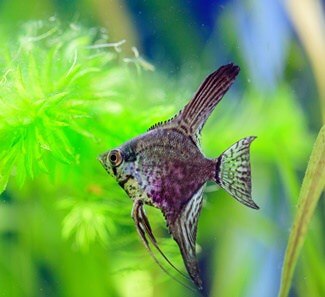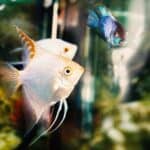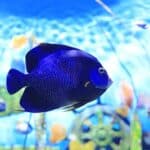Last Updated on: 16th April 2024, 11:12 am
Angelfish require oxygen to breathe. Getting the correct o2 levels inside the tank isn’t as simple as you might think. If the levels are too low or high, the angelfish can die.
Angelfish need around 8 PPM of dissolved oxygen to breathe. Too much oxygen can cause gas bubble disease, which can be lethal.
A sign that o2 levels are too high is too many bubbles in the tank. Low oxygen levels are caused by insufficient plants, too many fish, poor-quality substrate, and a lack of filtration.
Suffocating fish will gasp at the water’s surface, stop swimming, and lose their appetite.
When the tank’s oxygen levels aren’t right, we must act quickly to prevent the fish from suffocating. Preventative measures, like the right-sized tank, can avoid dangerous oxygen levels.
Do Angelfish Need Oxygen?
Angelfish don’t breathe in the same way as humans, but oxygen allows them to live. Therefore, oxygen is just as essential for their survival.
The angelfish heart has two chambers. The heart pumps blood to the gills, picking up oxygen and releasing carbon dioxide. The blood flows to the organs and tissues before returning to the heart. Therefore, oxygen keeps the respiratory process moving along safely.
Similarly, the tank needs oxygen to fuel the beneficial bacteria that break down oxygenated waste and remove harmful chemicals from the water.
Plants inside the tank also need oxygen to stay alive. If they don’t get enough o2, they decompose, raising ammonia and nitrites to harmful levels.
According to the U.S. Geological Survey, angelfish consume oxygen dissolved in the water through their gills, so the tank must be well-oxygenated to keep the fish alive.
How Much Oxygen Do Angelfish Need?
While the exact oxygen levels vary between fish species, angelfish do well with 8 PPM of dissolved oxygen in the tank. When more oxygen is in the water, more fish will stay alive. However, too much or too little oxygen can cause health problems.
According to the Florida Department of Agriculture and Consumer Services, the amount of oxygen that water can hold depends on its temperature, salinity, and atmospheric pressure.
While air pumps, bubbles, and oxygen diffusers help to add oxygen to the tank, angelfish don’t need them to survive. Instead, oxygen enters through the tank in two ways:
- Surface agitation.
- Plant photosynthesis.
Surface agitation oxygenates the water, promoting gas exchange. It increases the rate at which oxygen dissolves in the water and the rate at which carbon dioxide is released. The benefit of surface agitation is that it allows more fish in the tank.
With plant photosynthesis, plants inside the tank use light energy to convert carbon dioxide and water into glucose. The by-product is released as oxygen, which fish breathe into the body.
However, angelfish needs a filter. Water filters remove unwanted chemicals from the water, such as ammonia and nitrites. It also agitates the surface water, providing an oxygenation bay.
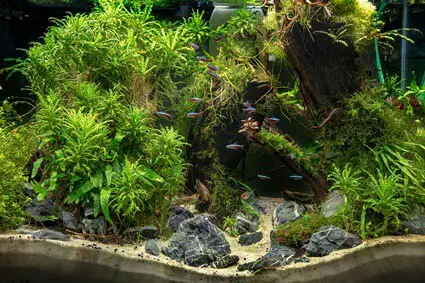
Does Too Much Oxygen Kill Fish?
Too much o2 in the fish tank can cause gas bubble disease, which is brought on when angelfish are exposed to water oversaturated with oxygen.
It occurs when the total pressure of dissolved gasses in the water exceeds the ambient atmospheric pressure.
Affected fish develop tiny bubbles in the eyes and skin. Sometimes, the bubbles occur in the angelfish’s organs. The bubbles eventually become bigger, causing floating problems and death.
Also, when the disease transforms into an air embolism, it blocks the lungs and blood vessels, leading to a slow and painful death.
Like too much oxygen, a lack of it can quickly kill fish. Angelfish die within 12 hours if placed in an aquarium without a filter. Overcrowding and low water quality expedite their demise.
When there’s insufficient oxygen inside the tank, angelfish suffocate and die. Similarly, oxygen reduces to dangerous levels when the temperature rises above 32 °C, killing the fish.
A dissolved oxygen meter can help you measure the oxygen in your angelfish tank. They’re not cheap and require regular servicing, but they’re accurate and can help prevent dangerous oxygen levels.
Signs of Too Much Oxygen In A Fish Tank
Too much oxygen in a tank is very unlikely. While gas bubble disease results from high oxygen levels, it’s more commonly caused by too much nitrogen.
As long as you’re using a stand aquarium setup and are maintaining adequate tank husbandry, you shouldn’t have an issue with too much oxygen. That being said, it can happen.
If your tank appears to bubble or fizzle like carbonated soda, it’s likely caused by high oxygen levels.
Similarly, strong currents inside the tank can also be a problem. Not only can this risk excess oxygen forming, but angelfish prefer quiet, slow-moving waters. If the current is too strong, angelfish will become stressed and struggle to breathe.
As a result, keep the aeration inside the tank to a safe minimum to ensure the fish are comfortable and you’re not risking the o2 levels getting too high.
If you suspect high oxygen levels, the only way to know is to test the water and apply the appropriate methods to fix them.
How To Decrease Your Tank’s Oxygen Levels
When the oxygen levels are too high, you must lower them to safe levels.
The oxygen levels inside a tank are rarely too high, but if it happens, you’ll need to spot the signs to correct them.
As a result, it’s possible to lower your aquarium’s oxygen levels through the following ways:
Raise The Water’s Temperature
Cold water holds more dissolved oxygen than warm water. If your tank’s oxygen levels are too high, it could be because the water is too cold.
You must keep the aquarium between 78° and 84° F. Angelfish prefer warmer temperatures, so anything between these figures should please the fish and maintain oxygen levels at a stable level.
Keep monitoring the temperature to ensure it’s not dropping unexpectedly. If so, there’s a problem with the tank that needs fixing.
Remove Excess Plants
If adding plants increases the tank’s oxygen levels, removing excess foliage should help to reduce them.
Overstocking a fish tank with plants looks aesthetically pleasing and provides plenty of hiding spots, but it can cause an overload of oxygen that makes fish unwell.
If this is the case with your tank, remove some plants. While they’re unlikely to do much damage, plants can be hard to maintain and die off quickly if not cared for.
Decaying plants may cause your tank’s oxygen and ammonia levels to rise to dangerous levels.
Remove Unnecessary Aeration Devices
Not all tanks require an aeration device to produce oxygen. For angelfish, surface water agitation is usually enough to give them all the o2 they need.
As a result, if your tank uses an aeration device it doesn’t need, you might be saturating the tank with oxygen, causing it to spike to dangerous levels.
The tank must be able to produce surface agitation. For many, a HOB filter is enough. Not only does it provide surface disturbance, but it moves oxygen to the bottom of the tank, increasing its concentration.
Remove excessive filters and monitor your fish to see if it improves.
Signs of Not Enough Oxygen in A Fish Tank
Unfortunately, it’s hard to tell when there’s insufficient oxygen in the fish tank until fish become affected.
Increasing the levels should improve the problem, but owners must adopt good aquarium maintenance and monitor oxygen levels to prevent a lack of oxygen in the tank. A lack of oxygen is caused by:
- Lack of aeration.
- Poor water quality.
- Stress.
If you notice your angelfish displaying the following signs, they might not be getting enough oxygen:
Gasping for Air
Angelfish that gasp at their tank’s surface suffers from a lack of dissolved oxygen. This is serious, as the fish are in survival mode and are fighting to stay alive.
Poor water quality, ammonia, and nitrites are leading causes of gasping, as these harmful chemicals take the oxygen out of the water. They also interfere with the fish’s gill function, preventing angelfish from being able to breathe in oxygen effectively.
If you have bubble filters, the angelfish will gravitate towards them to find oxygen. When your fish gasps at the surface, the situation is severe, and you must act fast.
Moving Less
Without oxygen to fuel them, angelfish become lethargic, and their energy levels drop. They may stop swimming or float close to the tank’s surface. If they are still able to swim, they appear imbalanced and uncoordinated.
When this happens, the water’s quality is likely compromised due to the factors causing a lack of oxygen. Angelfish are at risk of ammonia and nitrite poisoning if not suffocated by the lack of o2 first.
Loss of Appetite
When there’s not enough oxygen in the angelfish’s tank, they struggle to breathe, let alone eat. A lack of dissolved oxygen in the tank reduces an angelfish’s appetite – they’re also physically unable to eat.
When angelfish stop eating, they become unwell. Without the proper nutrients to sustain them, angelfish will quickly lose weight. In the worst cases, starvation leads to death.
A tell-tale sign that angelfish aren’t eating is uneaten food rotting at the bottom of the tank.
If you notice this, you need to deal with the insufficient oxygen levels and clean out the tank of decaying matter to prevent harmful chemicals from forming in the water.
Labored Breathing
Angelfish struggling to breathe will rapidly open and close their gills to find dissolved oxygen.
Healthy fish should breathe steadily. If a fish has to work too hard to breathe, something’s wrong – and it’s most likely the oxygen levels. To get your fish’s breathing back to normal, fix the tank’s conditions and monitor them to see if their breathing improves.
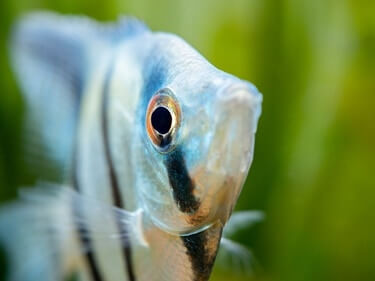
How To Increase Oxygen Levels
When there’s a lack of oxygen in the tank, you must work quickly to increase o2 levels before the fish die. Without enough oxygen, fish will suffocate, and you’ll lose your entire tank.
Even the plants will die, so you’ll need to start again by stocking the aquarium. These are some of the best ways to increase your tank’s oxygen levels:
Add Plants
Adding plants to the aquarium helps to boost oxygen levels naturally. Plants also provide valuable hiding spaces that angelfish can use to escape from territorial fish.
However, when adding plants, you also need to add light to allow photosynthesis to take place. Make sure you account for the tank’s depth. The oxygen supply will quickly deplete if the plants are in constant darkness.
Similarly, always clean out dead or dying plants and replace them with live ones to keep the oxygen levels up. This will also reduce the risk of harmful ammonia and nitrites forming.
Provide Proper Substrate
The substrate should give plants enough nutrients to grow and develop strong roots. This means they’re more likely to live longer and provide oxygen more efficiently.
Fine gravel, small stones, or sand are all good-quality substrates for use inside an angelfish aquarium. Dirt or loam soil provides a breeding ground for harmful bacteria, which can kill the plants. These materials should be avoided.
Ensure your chosen substrate comes with essential nutrients for plant growth. You can even add plant food to help the plants inside the tank grow.
Increase Aquarium Surface Area
When tanks have a larger surface area, there’s more oxygen. Before purchasing a tank, consider the shape and water capacity to provide enough oxygen for your angelfish.
If your tank is too small to provide all the oxygen your angelfish needs, it’s time to get something bigger before problems arise.
Increase Surface Agitation
As surface agitation is one of the main ways angelfish get their oxygen, increasing the water movement in the tank will help provide enough o2. You can do this with the following devices:
- Surface bubbler. This releases streams of bubbles and oxygen.
- HOB (hang on back) filter. You hang it on the back of the tank, and it releases water into the aquarium at the surface.
- Powerhead. This creates more water flow.
- Wavemaker. This creates waves that agitate the water’s surface.
- Spray bars and sprinklers. Both gently add water to the aquarium
You only need to choose one of these devices, but each one should boost the tank’s oxygen levels.
Decrease The Number of Fish
An overstocked tank means there’s less oxygen to go around, resulting in angelfish needing to compete for it. Overstocked tanks cause several problems, including:
- Increase in harmful chemicals.
- The risk of under and overfeeding.
- Aggression.
- Depressed fish.
Therefore, you mustn’t add too many fish to your tank to preserve the oxygen levels and keep your angelfish happy and healthy.
Monitoring the oxygen levels inside your angelfish tank is the best way to ensure everything is as it should be. Even the smallest oxygen rises or drops can be fatal, so observe your fish’s behavior for any noticeable changes, as this can show you when something’s wrong.

